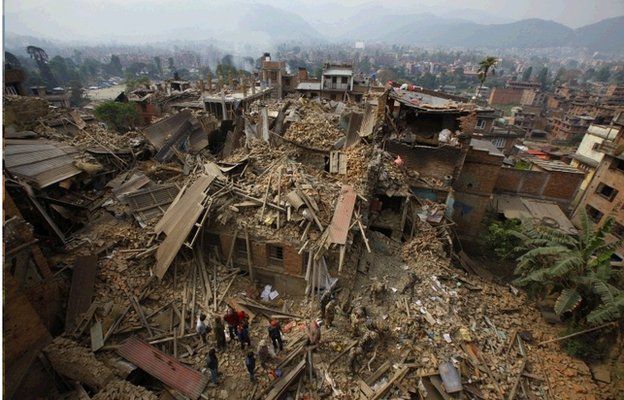In the midst of the picturesque beauty of the Himalayas lies a tale of tragedy that shook the world – the Nepal earthquake. You might have heard about it, but when exactly did this devastating event occur?
Today, we will take a closer look at the timeline of this tragic event and uncover the details you may have missed. So, fasten your seatbelt as we embark on a journey to discover when the Nepal earthquake truly happened.
Causes of the Nepal Earthquake
Tectonic plate movements
Tectonic plate movement was the main cause of the earthquake in Nepal. Nepal is situated in the seismically active region of the Himalayas, where the Indian Plate is colliding with the Eurasian Plate. This collision of plates results in immense pressure buildup and periodic release of energy in the form of earthquakes.
Main faults in Nepal
The two main faults in Nepal that contributed to the earthquake are the Main Himalayan Thrust (MHT) fault and the Lesser Himalayan Thrust (LHT) fault. The MHT fault, located at the interface between the Indian Plate and the Eurasian Plate, experienced a sudden slip resulting in the earthquake. The LHT fault, which lies above the MHT fault, also contributed to the seismic activity in the region.
Magnitude and Epicenter of the Earthquake
The moment magnitude scale
The Nepal earthquake, which occurred on April 25, 2015, had a moment magnitude of 7.8. The moment magnitude scale is a logarithmic scale that measures the size of an earthquake based on the amount of energy it releases. A magnitude of 7.8 indicates a major earthquake capable of causing significant damage and loss of life.
Location of the epicenter
The epicenter of the earthquake was located in Barpak, Gorkha, approximately 80 kilometers northwest of Kathmandu, the capital city of Nepal. The seismic waves radiated outwards from this point, causing widespread shaking and destruction throughout the country.

Devastation and Impact of the Earthquake
Loss of life
The Nepal earthquake resulted in a devastating loss of life. Thousands of people were killed, and countless others were injured or displaced. The earthquake struck during the daytime, when many people were engaged in their daily activities, exacerbating the impact on the population.
Damage to infrastructure
The earthquake caused extensive damage to Nepal’s infrastructure. Historical monuments, including UNESCO World Heritage sites, were reduced to rubble. Houses, buildings, roads, and bridges were destroyed or severely damaged, hindering rescue and relief efforts. The destruction of critical infrastructure further exacerbated the impact of the earthquake on the affected communities.
Aftershocks
Following the main earthquake, Nepal experienced numerous aftershocks, many of them significant in magnitude. These aftershocks not only traumatized the population but also posed additional risks of collapsing weakened structures. The prolonged series of aftershocks further hampered relief efforts and created a sense of fear and uncertainty among the affected population.
Response and Relief Efforts
Immediate response
Immediately after the earthquake, both local and international response teams mobilized to provide immediate assistance. The Nepalese government, aided by various national and international organizations, launched search and rescue operations, set up temporary shelters, and provided medical aid to the injured.
International aid
The international community rallied together to provide crucial aid and support to Nepal. Multiple countries dispatched search and rescue teams, medical personnel, and humanitarian supplies. Additionally, financial assistance was pledged to aid in the recovery and reconstruction process. The swift and collaborative international response played a crucial role in mitigating the immediate aftermath of the disaster.
Challenges in disaster response
The earthquake exposed several challenges in disaster response. Nepal’s rugged topography and poor infrastructure hindered timely access to remote and affected areas. Lack of coordination between various response agencies and limited resources complicated rescue and relief efforts. These challenges highlighted the need for improved disaster preparedness, infrastructure development, and efficient coordination mechanisms in future response efforts.

Effect on Nepal’s Economy
Tourism industry
The earthquake had a significant impact on Nepal’s tourism industry, which is a vital contributor to the country’s economy. Many popular tourist destinations, such as Kathmandu, Bhaktapur, and Pokhara, suffered extensive damage. The decrease in tourist arrivals and cancellations of pre-booked trips adversely affected businesses reliant on tourism, including hotels, restaurants, and travel agencies.
Agriculture sector
Nepal’s agriculture sector, which employs a significant portion of the population, was also severely affected. The earthquake struck during the planting season, disrupting agricultural activities and causing crop losses. The destruction of irrigation systems, storage facilities, and livestock also hindered the sector’s recovery. The impact on the agriculture sector posed challenges to food security and livelihoods for rural communities.
Reconstruction efforts
Rebuilding Nepal’s infrastructure and communities became a key focus in the aftermath of the earthquake. The task of reconstruction was immense, requiring significant financial resources and careful planning. The government, in collaboration with international partners and non-governmental organizations, initiated various reconstruction projects encompassing housing, schools, healthcare facilities, and heritage sites. These efforts aimed to not only restore what was lost but also to build back stronger and more resilient communities.
Lessons Learned and Preparedness
Building codes and infrastructure
The earthquake served as a wake-up call for the importance of robust building codes and infrastructure. The inability of many structures to withstand the seismic forces highlighted the need for stronger construction regulations and improved adherence to them. Strengthening existing buildings and ensuring future constructions meet proper safety standards became crucial in minimizing the impact of future earthquakes.
Emergency response planning
The Nepal earthquake exposed gaps in emergency response planning. The need for well-coordinated and efficient disaster management systems became evident. The government, in partnership with national and international agencies, has since worked on enhancing early warning systems, training emergency responders, and conducting preparedness drills to be better equipped for future disasters.
Rebuilding Nepal: Future Outlook
The role of government
The government of Nepal plays a central role in the reconstruction and recovery process. It is responsible for creating policies, coordinating relief efforts, and implementing long-term development plans. The government’s commitment to transparency, accountability, and inclusivity in the rebuilding process is vital to ensuring the equitable distribution of resources and the sustainable development of the country.
Community involvement and resilience
The active participation of affected communities in the reconstruction process is crucial for long-term success. Encouraging community engagement, empowering local leaders, and incorporating traditional knowledge and practices can foster resilience and ownership. By engaging communities, Nepal can build back stronger and ensure that the needs and aspirations of its people are met.
Sustainable development goals
The earthquake presents an opportunity for Nepal to align its reconstruction efforts with sustainable development goals. By integrating environmental sustainability, gender equality, and social inclusion into the rebuilding process, Nepal can build a more resilient and equitable society. Emphasizing sustainable infrastructure, renewable energy, and inclusive governance can set the foundation for a prosperous future.
Remembering the Victims
Commemoration events
Every year, Nepal commemorates the earthquake by organizing various events and memorial services. These events provide an opportunity for remembrance and reflection, allowing the nation to pay tribute to the lives lost and honor the resilience of the survivors. It serves as a reminder of the collective strength and unity that emerged in the face of tragedy.
Support for survivors and families
Support for survivors and the families of victims remains critical even years after the earthquake. Providing psychosocial support, access to healthcare, and educational opportunities can help survivors rebuild their lives and move towards a brighter future. Ensuring that the needs of vulnerable groups, such as children, women, and the elderly, are addressed is essential for fostering social cohesion and healing.
Global Solidarity and Support
International efforts
The Nepal earthquake sparked a global outpouring of solidarity and support. Countries around the world extended financial, technical, and humanitarian assistance to help Nepal recover and rebuild. The international community’s commitment to standing by Nepal during its time of need highlights the importance of global cooperation and solidarity in times of crisis.
Donor conferences
Donor conferences were held to mobilize financial resources and facilitate coordination between donors and the Nepalese government. These conferences brought together stakeholders from governments, international organizations, and the private sector to discuss and commit to supporting Nepal’s reconstruction efforts. The conferences served as platforms to share knowledge, exchange best practices, and promote long-term partnerships.
Humanitarian assistance
Humanitarian organizations played a crucial role in providing immediate assistance and long-term support to the affected population. They worked alongside local authorities to deliver essential supplies, restore basic services, and facilitate the recovery process. The tireless efforts of humanitarian workers, volunteers, and organizations showcased the power of compassion and solidarity in moments of crisis.
Conclusion
Reflecting on the tragedy of the Nepal earthquake evokes a range of emotions. It serves as a reminder of the fragility of life and the unpredictable forces of nature. However, through the devastation, there is hope for the future. Nepal’s journey towards recovery and resilience showcases the strength of its people and the power of global solidarity. By learning from the past and embracing sustainable development practices, Nepal can rebuild a brighter, more resilient future that honors the memories of those who lost their lives and supports the aspirations of its people.

